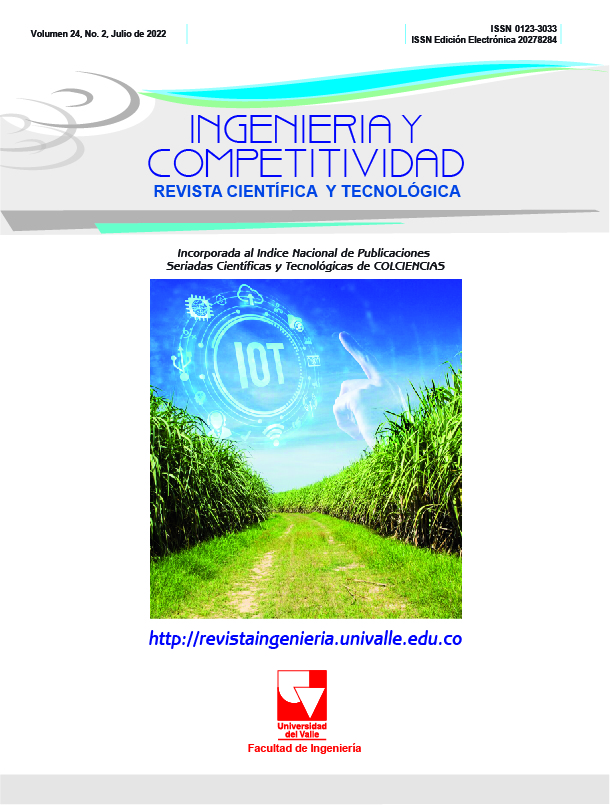Evaluación de herramientas computacionales para análisis de sistemas fotovoltaicos
Contenido principal del artículo
En este artículo se presenta la comparación de algunas herramientas de simulación para sistemas fotovoltaicos. El análisis se realizó considerando cuatro criterios: histórico de citaciones, accesibilidad, amabilidad con el usuario y simulación. Cada uno de estos criterios incluye aspectos a los cuales se les asignaron puntajes. Finalmente, se realizó la ponderación de los puntajes para definir la herramienta computacional que con más ventajas y potencial de utilizarse en el contexto colombiano. Los programas para simulación de sistemas fotovoltaicos con más ventajas para la simulación de sistemas fotovoltaicos son el PVSyst y el PV*SOL. Tanto su interfaz, como la información arrojada en la simulación, las hacen herramientas muy completas para el análisis de producción de energía de este tipo de sistemas. Los programas de simulación son necesarios para el análisis de la operación de sistemas fotovoltaicos. Entre los más utilizados se encuentran: PVSyst, PV*SOL, SAM y RETScreen. La evaluación de las herramientas permitió identificar que PV*SOL es el programa con más ventajas y fortalezas.
- Sistema fotovoltaico
- Simulación
- Software
- Sombreado
(1). J. E. Garzón Quintero, «Factores De Riesgos Ergonómicos Presentes En Los Trabajadores De Lineas Y Redes De La Empresa Electrificadora Del Huila S.A,» Neiva, 2009.
(2). V. Padmanathan, L. Joseph, B. Omar y R. Nawawi, «Prevalence of musculoskeletal disorders and related occupational causative factors among electricity linemen: A narrative review,» International Journal of Occupational Medicine and Environmental Health, vol. 29, nº 5, pp. 725-734, October 2016.
(3). A. DANE, «Minsalud,» 12 febrero 2020. [En línea]. Available: https://www.minsalud.gov.co/proteccionsocia l/RiesgosLaborales/Paginas/afiliacionsistema-general-riesgos-laborales.aspx. [Último acceso: 24 2 2021].
(4). S. Alabdulkarim y M. A. Nussbaum, «Influences of different exoskeleton designs and tool mass on physical demands and performance in a simulated overheaddrilling task,» Applied Ergonomics, vol. 74, pp. 55-66, August 2018.
(5). M. Abdelmomen, F. Ozan Dengiz, H. Samir y M. Tamre, «RESEARCH ON UPPER-BODY EXOSKELETONS FOR PERFORMANCE AUGMENTATION OF PRODUCTION WORKERS,» de 30TH DAAAM INTERNATIONAL SYMPOSIUM ON INTELLIGENT MANUFACTURING AND AUTOMATION. , Tallin, Estonia, 2019.
(6). T. Butler y J. C. Gillette, «Exoskeleton Used as PPE for Injury Prevention,» PROFESSIONAL SAFETY PSJ, pp. 33-37, March 2019.
(7). M. P. de Looze, T. Bosch, F. Krause, K. S. Stadler y L. W. O´sullivan, «Exoskeletons for industrial application andtheir potential effects on physical work load,» Ergonomics, vol. 59, nº 5, pp. 671-681, May 2015.
(8). T. Bosch, J. van Eck, K. Knitel y M. de Looze, «The effects of a passive exoskeleton on muscle activity, discomfort and endurancetime in forward bending work,» Applied Ergonomics, vol. 54, pp. 212-217, January 2016
(9). T. B. F. K. K. S. S. &. L. W. O. Michiel P. de Looze, «Exoskeletons for industrial application and their potential effects on physical work load,» Ergonomics, pp. 671- 681, 2016.
(10). I. Pacifico, A. Scano, E. Guanziroli, M. Moise, L. Morelli, A. Chiavenna, D. Romo, S. Spada, G. Colombina, F. Molteni, F. Giovacchini, N. Vitiello y S. Crea, «An Experimental Evaluation of the Proto-MATE : A Novel Ergonomic Upper-Limb Exoskeleton to Reduce Workers' Physical Strain,» IEEE ROBOTICS & AUTOMATION MAGAZINE, vol. 27, nº 1, pp. 54-65, 2020.
(11). T. Schmalz, J. Schandlinger, M. Schuler, J. Bornmann, B. Schirrmeister, A. Kannenberg y M. Ernst, «Biomechanical and Metabolic Effectiveness of an Industrial Exoskeleton for Overhead Work,» International Journal of Environmental Research and Public Health, vol. 16, nº 23, November 2019.
(12). L. H. Barrero, J. A. Pulido, S. Berrio, M. Monrroy, L. A. Quintana y C. Ceballos, «Physical workloads of the upper extremity among workers of the Colombian flower industry,» American Journal of Industrial Medicine, vol. 55, nº 10, pp. 926-936, July 2012.
(13). L. H. Barrero, C. Ceballos, R. Ellegast, J. A. Pulido, M. Monroy, S. Berrio y L. A. Quintana, «A randomized intervention trial to reduce mechanical exposures in the Colombian flower industry.,» Work, vol. 41, nº 1, pp. 4971-4974, 1 January 2012.
(14). S. Peláez y L. A. Quintana, «Assessment of Muscular Activity and Postural Load During Coffee Harvesting Activities – A Case Study,» Ingeniería y Universidad, vol. 24, nº 1, Febrary 2020.
(15). S. Berrio, L. H. Barrero y L. A. Quintana, «A field experimento comparing mechanical demandsof two pruners for flower cutting,» Work, vol. 41, nº 1, pp. 1342-1345, 2012.
(16). A. Blanco, J. M. Catalán, J. A. Díez, J. V. García, E. Lobato y N. GarcíaAracil, «Electromyography Assessment of the Assistance Provided by an UpperLimb Exoskeleton in Maintenance Tasks,» Sensor, vol. 19, nº 15, 2 agosto 2019.
(17). A. O. Perotto, Anatomical Guide for the Electromyographer: The Limbs and Trunk., 5th ed., T. Books, Ed., Springfield: Charles C Thomas, 2011.
(18). H. Hermens, B. Freriks, C. Disselhorst y G. Rau, «Development of recommendations for SEMG sensors and sensor placement procedures,» Journal of Electromyography and Kinesiology, vol. 10, nº 5, October 2000.
(19). B. Jonsson, «The static load component in muscle work.,» European Journal of Applied Physiology and Occupational Physiology, pp. 57(3), pp.305-310.,, 1988.
Descargas

Esta obra está bajo una licencia internacional Creative Commons Atribución-NoComercial-CompartirIgual 4.0.
Los autores que publican en esta revista están de acuerdo con los siguientes términos:
Los autores ceden los derechos patrimoniales a la revista y a la Universidad del Valle sobre los manuscritos aceptados, pero podrán hacer los reusos que consideren pertinentes por motivos profesionales, educativos, académicos o científicos, de acuerdo con los términos de la licencia que otorga la revista a todos sus artículos.
Los artículos serán publicados bajo la licencia Creative Commons 4.0 BY-NC-SA (de atribución, no comercial, sin obras derivadas).


 https://orcid.org/0000-0001-7679-102X
https://orcid.org/0000-0001-7679-102X https://orcid.org/0000-0001-8843-0918
https://orcid.org/0000-0001-8843-0918 https://orcid.org/0000-0002-8658-614X
https://orcid.org/0000-0002-8658-614X


